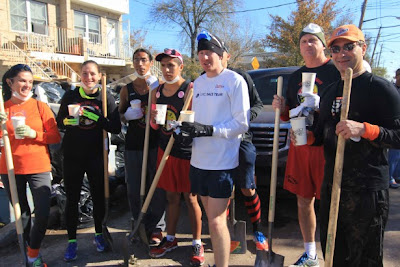Editor's note: I am backlogged a bit. This entry entails the last week of October/first week of November...
Superstorm
Sandy came to town and threw a wrench in my plans. I was suppose to
drive up to NYC on the Monday before Halloween to do TV work for the New
York Road Runners, but Amtrak wasn't running trains. So, I waited.
By
Wednesday trains still weren't running north of Newark so I got in my
ca r and drove to the big city. That morning I got in an easy 9 miles. I
was too busy on Thursday to run, but had a chance to get out on Friday
for a jaunt along the Westside Highway. Central Park was shut down due
to the storm damage, so running the wasn't an option. It was monotonous,
but better than not running at all. I just wanted to get the run done
with and never ran much slower than 6:25 pace for the duration of the 9 miles. I ran past 2:03 man Moses Mosop, who I had interviewed a day earlier, and we exchanged stoic pleasantries.
That
night the NYRR canceled the marathon and all hell seemed to break
loose. On Saturday I took to Central Park, which had just opened, and
witnessed thousands of runners hamster wheeling around the park's 10k
perimeter. Again, I was short on time, so I pressed the pace and covered
the loop in 37 minutes. As I approached the marathon's finish line, I
saw a man weeping openly. Obviously, he would have to wait another year
to get his chance in Gotham. It was a sad sight, but nothing like what I
would bare witness to the next day.
On what
would have been race day, I was tasked with joining a half dozen Lakota
Indians from South Dakota on their quest to hand out food and supplies
to grief-stricken people on State Island. In lieu of racing, the Lakota
wanted to help and since they were a group we had been documenting from
the beginning, we simply followed the story. We met in midtown and then
drove to the southern tip of Manhattan before boarding the ferry, as
everyone would have done on race day. It was 100% grassroots driven by
social media - thousands of runners had answered the call. In a way,
everyone was ready for such a mission, but instead of racing a marathon
everyone would instead be running to hard to reach areas with supplies
on their backs not easily accessible by cars since fuel was very hard to
come by. Once on Staten Island, I slipped out of my jeans and laced up
my running shoes. Armed with a GoPro and a cell phone I took off with
the masses towards some of the worst hit areas. Having grown up on Cape
Cod, I've seen my fair share of hurricanes and tropical storms, but I
had never seen anything like this:
Beach
parking lots were turned into aid stations. Hundreds of people were
unloading and organizing diapers, water, foodstuffs, clothes and shoes.
Fire trucks and cop cars flying past with sirens blaring. Blocks and
blocks of homes that had been gutted bay 14 foot wall of water. Some
homes were leveled. No power to speak of. Cars filled with water. Cars
without gas.
After handing out our supplies, we
started helping some home owners shovel out waterlogged dry wall and
insulation from their first level floors. Almost a week after the storm,
water still flowed out from the rafters with ease. One volunteer found a
foot long fish in someone's dresser. I worked to stay warm, since my
jeans and jacket were in our production van somewhere on the way to
where we were situated. Volunteers marched the streets and gave out hot
soup and coffee. One home owner gave me a swig of Dewar's White Label
and thanked me for coming. The Lakotas continued to schlep out debris
and remarked how they knew a thing or two about "hard times" and were
happy to assist in anyway they could. We had to drag them away insisting
they had to get into our van as that was the only way off the island.
It
was a sobering day, for sure, but heartwarming at the same time. It was
great to see runners using their legs as a vehicle to do good.
The next day I drove back to Maryland and prepared to switch gears; on Tuesday Emily and I would be driving across the country.

No comments:
Post a Comment